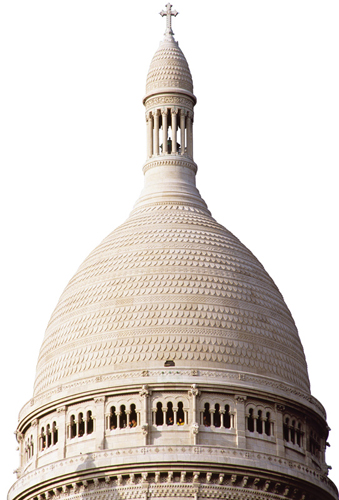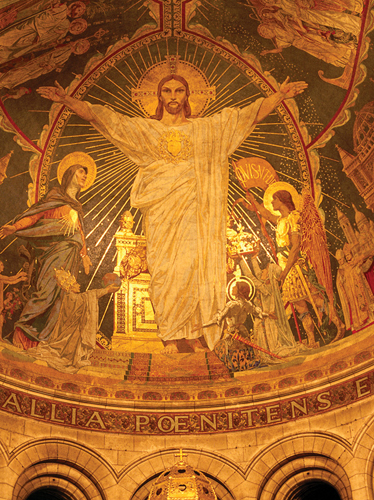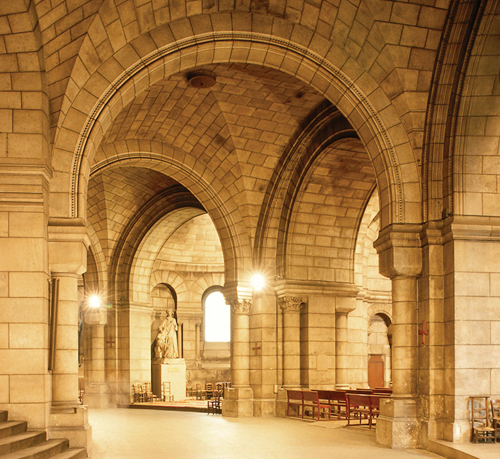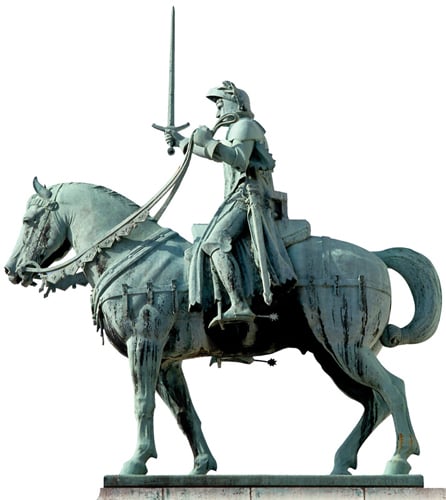One of the most photographed images of the city, the
spectacular white outline of Sacré-Coeur (Sacred Heart) watches over
Paris from its highest point. The basilica was built as a memorial to
the 58,000 French soldiers killed during the Franco-Prussian War
(1870–71) and took 46 years to build, finally completed in 1923 at a
cost of 40 million francs (6 million euros). Priests still pray for the
souls of the dead here 24 hours a day. Although the interior is less
impressive than many other churches in the city, people flock here for
the panoramic views – at sunset, in particular, there are few sights in
Paris more memorable.
Parvis du Sacré-Coeur, 75018 01 53 41 89 00
www.sacre-coeur-montmartre.com
Open 6am–11pm, last entry 10:15pm (basilica), 9:30am–5:30pm (dome and crypt) daily Admission €5.00 (dome and crypt only) No disabled access
|
|
In 1870, as Prussia made
moves to take over Germany, France was also threatened by its military
power. Two Catholic businessmen in Paris vowed to build a church
dedicated to the Sacred Heart if France were spared the Prussian
onslaught. France declared war on Prussia in July, but she was
ill-prepared and in September Napoleon III was captured. Parisians held
fast, however, defending their city with homemade weapons and eating
dogs, cats and rats. But by January 1871 they surrendered.
|

Sacré-Coeur dome
|
Avoid the crowds and head to 23 rue des Abbesses and grab a bite at the St Jean or try Café Anosé at 123 rue Caulaincourt.
|
|
|
An evocative sung Mass takes place on Sundays at 11am.
|
|
Top 10 FeaturesGreat Mosaic of Christ A
glittering Byzantine mosaic of Christ, created by Luc Olivier Merson
between 1912–22, decorates the vault over the chancel. It represents
France’s devotion to the Sacred Heart.

Crypt Vaults The
most interesting feature of the interior is the arched vaults of the
crypt. A chapel contains the heart of Alexandre Legentil, one of the
advocates of Sacré-Coeur.

Bronze Doors The
doors of the portico entrance are beautifully decorated with bronze
relief sculptures depicting the Last Supper and other scenes from the
life of Christ.

The Dome The
distinctive egg-shaped dome of the basilica is the second-highest
viewpoint in Paris after the Eiffel Tower. Reached via a spiral
staircase, vistas can stretch as far as 48 km (30 miles) on a clear day. Statue of Christ The
basilica’s most important statue shows Christ giving a blessing. It is
symbolically placed in a niche over the main entrance, above the two
equestrian statues. Bell Tower The beautiful campanile,
designed by Lucien Magne and added in 1904, is 80 m (262 ft) high. One
of the heaviest bells in the world, the 19-ton La Savoyarde hangs in the
belfry. Cast in Annecy in 1895, it was donated by the dioceses of
Savoy.

Equestrian Statues Two
striking bronze statues of French saints stand on the portico above the
main entrance, cast by H Lefèbvre. One is of Joan of Arc, the other of
Saint Louis.

Stained-Glass Gallery One level of the great dome is encircled by stained-glass windows. From here there is a grand view over the whole interior. Façade Architect
Paul Abadie (1812–1884) employed a mix of domes, turrets and Classical
features in his design. The Château-Landon stone secretes calcite when
wet and bleaches the façade white.

The Funicular To avoid the steep climb up to Sacré-Coeur, take the funiculaire cable railway and enjoy the views at leisure. It runs from the end of rue Foyatier, near Square Willette.
|